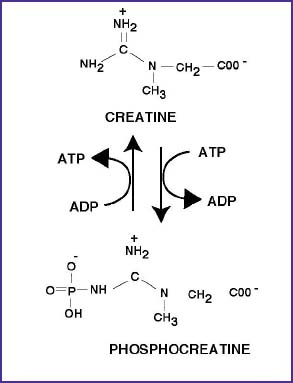Creatine is the powerhouse that offers additional fuel to the body during intense activity. It does so by aiding the body’s production of ATP. ATP is the gas tank of the human body storing energy for all living cells. This makes the rapid production of ATP vital to maintaining energy.
What is ATP?
ATP is known as Adenosine TriPhosphate and the molecule that stores energy in all living cells. All physiological mechanisms that require energy to function obtain it from ATP. ATP is composed of adenosine with three attached phosphate molecules. ATP releases energy during breakdown and causes it to hydrolyze into ADP (Adenosine DiPhosphate, which is adenosine with 2 phosphate molecules).
How does creatine help generate ATP?
Creatine via supplementation is stored in muscles. Creatine is stored in the form of phosphocreatine. Phosphocreatine provides a source of phosphate that’s broken off and attaches to ADP. This additional phosphate creates a regenerated molecule of ATP.

Unfortunately, this regeneration only lasts for a short period of time. The end result is muscle fatigue. The normal turnover rate of creatine is about 2 grams per day. This is why supplementation is crucial as it increases the body’s storage of creatine. Enhanced storage means more creatine (which is formed to phosphocreatine by borrowing a phosphate molecule from ATP which is later “returned” to ATP) and further generation of ATP beyond normal levels.
The body has a saturation point for creatine. This means any excess creatine will be excreted through urine. This is why understanding dosing is key. Creatine may or may not require a loading phase. This depends on the duration of creatine usage. Studies show creatine levels saturate at 28 days through standard dosing protocols without loading. We will look at the dosing recommendations with 3 standard phases; loading, maintenance, and washout.
Phase 1. Loading
This involves a high dosing scheme over 2 to 7 days to quickly saturate creatine stores. Studies have found that 20 grams per day split into 4 doses works best. Space the doses out evenly throughout the day. This is because the body can only absorb a little over 5 grams after ingestion (Note: This is dependent on total muscle mass related to bodyweight).
Creatine loading periods depend on muscle mass, bodyweight, and diet. Vegetarians naturally get less creatine from their diets due to food choices. The most consistent dosing scheme based on research and controlling dependencies is 20 grams per day.
Loading scheme based on weight:
150 pounds or less – 2 to 3 day loading period
151 to 200 pounds – 4 to 5 day loading period
200 or more pounds – 6 to 7 day loading period
For those using creatine for extended periods, the loading period may not be necessary. This is due to studies showing that consistent dosing for 28 days results in muscle creatine saturation. Thus it would be wise to move directly to phase 2 and skip phase 1. Though loading allows creatine stores are saturated quickly potentially allowing faster results and strength increases.
Maintenance
The maintenance dose requires significantly less creatine per day. The doses can be taken all at once or split into two doses. The most effective daily doses based on studies is .03 grams per kilogram of bodyweight (Note: If you need to convert your weight in pounds to kilograms, simply divide your bodyweight by 2.2, i.e. bodyweight is 200lbs, so 200/2.2 = 90.91kg).
Washout
The final phase is a cleaning out period that is referred to as washout. This period allows the body to clear out the supplemented creatine. The washout period depends on the individual similar to the loading period. Studies show that creatine stores can remain elevated up to 2 weeks after the final dose. These studies show support for a 4 week washout phase which is pushed to around 30 days. Thus washout phase should be at least 30 days to ensure the levels have returned to baseline.
Creatine has been extensively studied for decades. It has been used for long periods and short periods. These periods range from 4 weeks to more than 12 weeks. Long term research is needed to understand any potential side effect from long term usage. With this knowledge it would be best to cycle creatine for 8 to 12 weeks on followed by a 4 week washout period.










